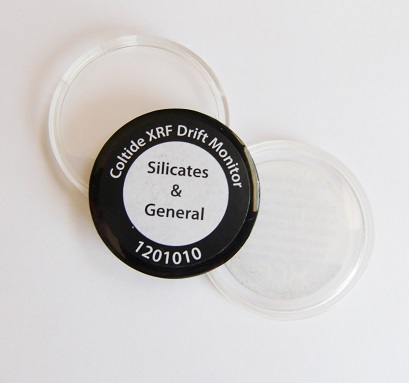What are Drift Monitors for XRF Instruments?
In x-ray fluorescence (XRF) spectrometry, samples are bombarded with incident x-rays that ionize the surface atoms of a sample material. This causes electrons to displace from their atomic orbits with a release of fluorescent energy that is characteristic of specific elemental signatures. A sensitive photodetector then acquires these relatively weak fluorescent signals with high rejection of backscattered and incident x-rays, to form a precise quantitative picture of the sample’s elemental composition on the major, trace, and ultra-trace levels.
XRF instruments are engineered to perform these incredibly precise analytical assessments of sensitive oxides with outstanding degrees of repeatability. This requires a precise combination of high-purity sample preparation and unerring calibration to ensure that XRF instruments are performing reliably throughout their lifespan.
Despite the strengths of modern XRF instruments, the primary x-ray source can still be subject to gradual mechanical drifting that can radically impact the accuracy of results. If left unchecked for long periods, this can reduce the efficacy of the device and shorten the service periods between mandatory recalibration.

Drift Monitors for XRF Instruments
To guarantee the ongoing reliability of results and optimal fluorescent detection rates, it is advisable to perform consistent process control tests of an XRF instrument using a drift monitor.
Drift monitors are engineered to exhibit count rates appropriate for specific applications. While their elemental composition is designed to be chemically alike samples that are regularly subjected to tests, their count rates do not require the same contingency. Instead, the count rate of the drift monitor is formulated to display a magnitude correspondence with sample minerals to support reliable long service for assessing mechanical drift of the XRF instruments’ x-ray source over time.
XRF instruments require regular assessment using a drift monitor, although the component should not be considered a calibration standard or a Certified Reference Material (CRM).
At XRF Scientific, we supply a range of drift monitors of distinct chemical compositions to support regular drift correction of XRF instruments in a range of fields. These include:
- Silicates
- Iron ore
- Bauxite
- Mineral Sands
- Cement
- Manganese
- Nickel
- Rare earth
- Sulfides
Each of these has been developed with negligible flux content and should display excellent long-term stability for reliable drift monitoring of your XRF instrument.
Calibrating XRF Instruments with XRF Scientific
XRF Scientific is a leading supplier of sample preparation equipment for XRF analysis in a range of fields. We supply CRMs for calibration of XRF instruments and method development, alongside our range of high-stability Ausmon drift monitors.
If you would like any more information about calibrating and maintaining the accuracy of XRF instruments, read Using Reference Materials for XRF Analysis. Or, contact us if you would like to discuss our drift monitors in further detail.









